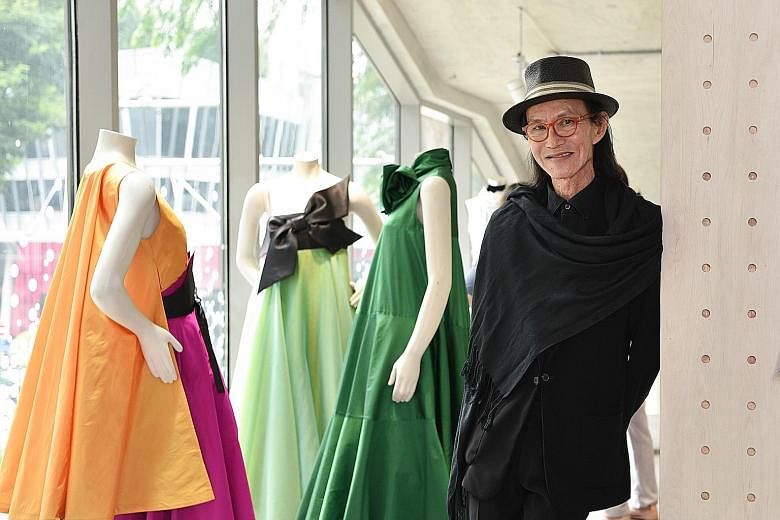The issue has persisted. But today, that means designers end up producing similar-looking collections in the same fabrics, or they lose out to fast-fashion retailers which offer more variety for cheaper, says Lee.
"I went into (multi-label retail store) Design Orchard and the standard of clothing stocked there is shocking. Things are so basic and there's no nice fabrication or nice finishing.
"You get better clothes at Zara for less money - designs are more interesting and there's fast turnover of new styles.
"There are so many choices now. As a young Singaporean designer, where and how would you fit into this whole retail environment?" he adds.
"We need to go back to our dressmaking days because that makes it unique."
MASKS AND VIRTUAL GIMMICKS NOT LONG-TERM SOLUTION
The pandemic has also led to debate on what is essential in fashion. In the interim, designers and local retail brands alike have turned to making masks.
Couturier Ann Teoh, who is in her 50s, believes it is the most essential thing designers can offer now.
The fashion veteran known for her bridal couture recently started selling hand-stitched designer masks under her diffusion line At.titude by Ann Teoh.
"I never imagined I, a couturier, would one day be making and packing masks," she says.
She hopes, once Covid-19 passes, to "meet future demands with essential clothes" - season-less items that look classic and last longer.
"The business model of ready-to-wear with racks and racks of clothes in a standalone boutique is not sustainable anymore. Too much money goes to landlords."
And making masks is not a long-term solution, say some.
-
Can the luxury market be sustained?
-
After lockdowns in China were lifted in April, Hermes' flagship store in Guangzhou reportedly chalked up 19 million yuan (S$3.7 million) in sales just one day after reopening. Wealthy shoppers were flocking to the store for "revenge buying" - binge shopping to make up for lost time.
This has had many wondering: Will the luxury market survive post-pandemic? Definitely, say some local designers. The luxury market comes with a premium that is hard to erode.
"Luxury brands already have a DNA - all they need is to throw money into advertising and promotion," says retired couturier Thomas Wee, 72.
Designer Wykidd Song, 56, believes the luxury sector will come out "intact".
"They will thrive because unlike fast fashion, they represent what creativity and fashion are at different taste levels," he says.
However, some are doubtful. Couturier Ann Teoh believes that demand for luxury may stay low for the next few years.
"Very few people have made money from the pandemic, and can they sustain all these luxury labels? Even the rich are losing millions a day. Until they start to make money and gain confidence again, they won't spend."
In the meantime, luxury houses - a sector often regarded as being slow or resistant to e-commerce - have adapted to offering online services to woo customers.
Italian jeweller Bvlgari launched an e-shop last month, complete with an e-concierge team to assist shoppers, and 3D product images and augmented reality for the brand's bags.
This month, Michael Kors launched a new Chat & Shop home shopping service, enabling shoppers to browse an e-catalogue of new arrivals before placing an order via e-mail.
And while luxury houses Chanel and Dior have chosen to retain a sense of elusiveness by not caving in completely to e-commerce, they quickly launched e-concierges and home delivery services for their beauty arms.
Luxury or not, brands will benefit from having a premium, says Wee. "The most important thing for a designer to do is make sure his work smells luxurious and spells 'designer'.
"It must have a premium, so when people buy them, they feel proud to have this label on their garments.
"When good times come back, luxury brands are not going to be affected. You'll see queues outside their doors again."
Wee says: "I think it's definitely not realistic. What kind of quantity are they producing to make a profit? After Covid-19, will consumers keep the masks for another pandemic or as collectible items?"
These are temporary solutions that distract from the real issues, such as the difficulty of gaining support locally and regionally.
It was the main reason Ms Tjin Lee, 46, who has organised 11 editions of Singapore Fashion Week, decided to exit the national runway show in 2017.
"It had become very clear that our country was too small to support a world-class, private-sector funded fashion week," says Ms Lee, whose company Mercury Marketing & Communications organised the Singapore Fashion Festival in 2004 and 2008; Audi Fashion Festival Singapore from 2009 to 2014; and Singapore Fashion Week from 2015 to 2017.
For the last two editions of the festival, she tried turning the focus on Asian designers. "But it didn't translate well in terms of sponsorship funding and brand partnerships from local businesses," she says.
"Despite our best efforts to highlight local and Asian, the sponsors were more keen on international blockbuster content. And as Singapore Fashion Week was 80 to 90 per cent privately-funded, this became unsustainable."
She tried moving with the times, investing in Digital Fashion Week to see if online runway shows and virtual experiences could add value, but found that did not translate well for a local and regional audience.
"The experience of seeing a fashion collection in real life cannot easily be replicated online."
Her team discussed the possibility of a joint Asia Fashion Week with regional organisers, but later decided against it.
"The biggest challenge in 2017 was that, despite our passion for supporting local and Asian designers, Asia wasn't all that interested in Asian designers as a whole," says Ms Lee.
"For local and Asian designers to thrive, their own home countries and region need to be supportive."
RETHINKING SAVVY MARKETING FOR THE FUTURE
Still, it is not all doom and gloom.
Predicting long-term disruption to the international fashion week schedule - as "the global industry is deep in soul-searching" about sustainability and the relevance of fashion - Ms Lee believes "fashion is a form of self-expression and culture and will always survive".
"Perhaps while international borders are closed, we can appreciate the local talent in our own backyard," she adds.
Breakthroughs in e-commerce will likely continue beyond the pandemic - but even so, brands should not get complacent, say designers.
Fashion requires stamina and constant innovation "beyond just investing in the first three years", says Wee.
Believing much of the work lies in the hands of those in marketing and visual merchandising, he recommends bringing back small fashion shows staged in mall atriums to promote young designers and setting aside a budget for pop-ups and adventurous fashion window displays.
Landlords should also work together with retailers, say those interviewed.
Rather than have vacant shop lots, landlords can consider more creative solutions to feature local fashion.
Dick Lee and Wee both pointed to shopping mall Siam Centre in Bangkok as an example, where an entire floor is dedicated to local designers.
"Not because (the designers) have deep pockets or supporters, but because the malls are willing to take a risk to see who they can invest in," says Wee.
It is a destructive cycle if nobody makes the first move, he adds.
"Right now, there are no distinctive brands or designers to give big companies the confidence to sponsor and invest in fashion. And if organisers can't get sponsors, they won't do anything."
While Lee too is not optimistic, he has a bold suggestion: Singapore designers could potentially stand out by specialising in Cruise Collections.
A newer fashion concept in the fashion calendar, a Cruise Collection is a mid-season capsule of resortwear, originally targeted at the elite who want to spend their winter holidays at a summer destination.
"Our tropical climate is unique to us," says Lee. "It's contentious, but a Cruise Collection could help us - it's doing a summery holiday collection in the middle of winter; and that's what we are."
"And Cruise is only once a year - which our designers can manage."
In the meantime, players in the industry can only sit tight and hope to ride out Covid-19. If designers and retailers were afraid to make moves before, they are only more risk-averse now.
"The Government and organisations like the Textile and Fashion Federation (TaFF) have given support many times over the years, but nobody has come out of it successfully - so I think they're very wary of doing another big thing," says Lee.
Wee adds: "I just hope that in the next two to three years, after Covid-19, there is a new breed of designers who will make me sit up and say 'wow, that's the future'."


